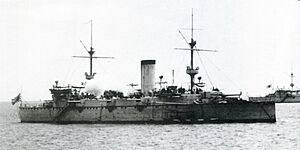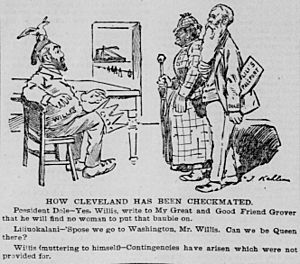Black Week (Hawaii) facts for kids
Quick facts for kids Black Week |
|||||||
|---|---|---|---|---|---|---|---|
| Part of Hawaiian Rebellions (1887–1895) | |||||||
 USRC Thomas Corwin, whose unexpected arrival caused the incident |
|||||||
|
|||||||
| Belligerents | |||||||
| Commanders and leaders | |||||||
| Strength | |||||||
|
United States
United Kingdom
|
1,000 militiamen
|
||||||
The Black Week was a tense time in Honolulu, Hawaii. It almost led to a war between the local Provisional Government and the United States. This event happened in late 1893 and early 1894.
Contents
Why the Black Week Happened
The Overthrow of the Hawaiian Kingdom
Before the Black Week, the Hawaiian Kingdom was overthrown. This happened in 1893. The Provisional Government took control.
President Cleveland's Plan
The U.S. President, Grover Cleveland, was not happy about this. He wanted to help restore the Hawaiian monarchy. He believed the overthrow was wrong.
President Cleveland sent James Blount to Hawaii. Blount was a special investigator. His report, called the Blount Report, looked into the overthrow.
After Blount, Albert Willis became the new U.S. Minister to Hawaii. Willis started talking with the former queen, Liliuokalani. He hoped to find a way to bring her back to power. There were even talks about the U.S. helping with an invasion. However, these plans did not work out.
The Crisis in Honolulu
Willis Arrives in Hawaii
On December 14, 1893, Albert Willis arrived in Honolulu. He came on the ship USRC Corwin. His arrival was a surprise. Many people thought it meant an American invasion was coming. This caused a lot of fear.
A Mock Invasion
Willis made the fears even stronger. He staged a fake invasion. He used two U.S. Navy ships, the USS Adams and USS Philadelphia. Their guns were pointed at the capital city.
Willis wanted to scare the Provisional Government. He hoped they would give the island back to the queen. He also wanted them to believe a U.S. invasion was possible. He even ordered Rear Admiral John Irwin to prepare troops. These troops were on the American ships. They got their equipment ready on deck.
Growing Public Fear
The public in Hawaii did not know what was really happening. News from the U.S. was slow to arrive. Sanford B. Dole, the President of Hawaii, tried to calm people. He told them there would be no invasion.
But the fear grew. By January 3, 1894, the situation was very tense. This is why the event became known as the “Black Week.”
International Concern
As the tension grew, Admiral Irwin worried about American citizens. He also worried about their property in Honolulu. He thought he might actually need to land troops to protect them.
Other countries also had ships nearby. The commanders of the Japanese cruiser Japanese cruiser Naniwa and the British cruiser HMS Champion offered to help. They wanted to protect their own citizens and property.
The Hoax Revealed
Finally, on January 11, 1894, Willis told Dole the truth. The whole invasion threat was a hoax. It was a trick to pressure the government.
What Happened Next
A New Government
Willis's plan did not bring the monarchy back. However, it did make the Hawaiian public doubt the Provisional Government. It also showed that the U.S. was ready to take strong action.
This situation helped lead to a new government. President Cleveland saw this as a step forward. He preferred Hawaii to be independent. He did not want it to become a U.S. territory yet.
Shortly after, on July 4, 1894, the Provisional Government changed its name. It officially became the Republic of Hawaii.



